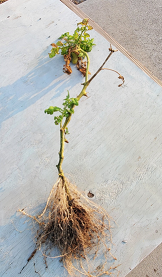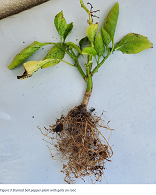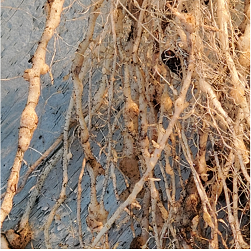
It is nearing the end of the Spring vegetable gardening season here in Central Florida. Some of you might be frustrated with some of your vegetable plants. They get watered, fertilized, and insect pests are controlled. Still, the plants look sickly and provide very few low-quality fruits.
So what’s up with the poor growth?
It is likely that your plants are being attacked by NEMATODES! I can hear you now, “What kind of toads?” Not “toads”, but nematodes. Nematodes are microscopic, soil-borne, aquatic, parasitic worms.

One of my volunteers had this same complaint for me last week. I went to the lackluster tomato vine and pulled it up from the soil. The roots were gnarled and looked as if someone had tied small knots in them. Then, I pulled out a similarly stunted bell pepper plant. It, too, sported matching lumpy roots.
Root-knot nematodes are one of a vegetable gardener’s worst nightmares. They feed on a variety of ornamental and vegetable crops but their favorites are members of the Solanaceae family.

The Solanaceae family of vegetables include but are not limited to:
- tomatoes
- peppers
- eggplant
- potatoes
It is best to prevent nematodes from colonizing your garden space. But it is already too late for that once your tomatoes and peppers are looking this bad and not thriving.
Can I get rid of nematodes?
At this time, there is no “magic bullet” cure for nematodes in your soil. However, there are many ways to manage nematodes in your soil.
- solarization
- cover cropping (or inter-cropping)
- trap cropping
- crop rotation
One of the best combination methods involves rotation of crop families from August to May and cover-cropping from May to August. Ensure that each vegetable garden bed goes through a full season with each vegetable family on the following list. Only after at least four harvests should the same “family” be allowed back into that plot. Your garden plan should look something like this:

The example to the left is a plan for two garden plots, with a full rotation and summer cover cropping. Notice it takes over two years for a plant family to occupy the same garden space again. For ease of planning, use the information from UF/IFAS publication #ENY862 on crop rotation along with the UF/IFAS publication #SP103, Vegetable Gardening Guide charts to help identify plant families and the best times to grow each of them. Carefully select seeds or starter plants that are labeled “nematode resistant’.
For more University of Florida gardening publications, please visit their Electronic Data Information Source (EDIS) website at: https://edis.ifas.ufl.edu. You can look up plant families, cover and trap cropping, and even “Organic Vegetable Gardening in Florida”.
 1
1
